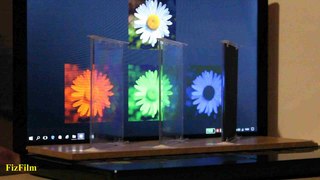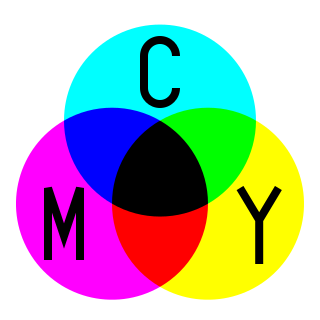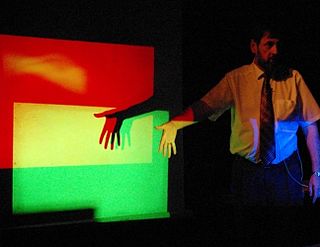
In computing, a printer is a peripheral machine which makes a persistent representation of graphics or text, usually on paper. While most output is human-readable, bar code printers are an example of an expanded use for printers. Different types of printers include 3D printers, inkjet printers, laser printers, and thermal printers.

The RGB color model is an additive color model in which the red, green and blue primary colors of light are added together in various ways to reproduce a broad array of colors. The name of the model comes from the initials of the three additive primary colors, red, green, and blue.

The CMYK color model is a subtractive color model, based on the CMY color model, used in color printing, and is also used to describe the printing process itself. The abbreviation CMYK refers to the four ink plates used: cyan, magenta, yellow, and key (black).

A set of primary colors or primary colours consists of colorants or colored lights that can be mixed in varying amounts to produce a gamut of colors. This is the essential method used to create the perception of a broad range of colors in, e.g., electronic displays, color printing, and paintings. Perceptions associated with a given combination of primary colors can be predicted by an appropriate mixing model that reflects the physics of how light interacts with physical media, and ultimately the retina.

Magenta is a purplish-red color. On color wheels of the RGB (additive) and CMY (subtractive) color models, it is located precisely midway between red and blue. It is one of the four colors of ink used in color printing by an inkjet printer, along with yellow, cyan, and black to make all other colors. The tone of magenta used in printing, printer's magenta, is redder than the magenta of the RGB (additive) model, the former being closer to rose.

Inkjet printing is a type of computer printing that recreates a digital image by propelling droplets of ink onto paper and plastic substrates. Inkjet printers were the most commonly used type of printer in 2008, and range from small inexpensive consumer models to expensive professional machines. By 2019, laser printers outsold inkjet printers by nearly a 2:1 ratio, 9.6% vs 5.1% of all computer peripherals.As of 2023, sublimation printers have outsold inkjet printers by nearly a 2:1 ratio, accounting for 9.6% of all computer peripherals, compared to 5.1% for inkjet printers.

Halftone is the reprographic technique that simulates continuous-tone imagery through the use of dots, varying either in size or in spacing, thus generating a gradient-like effect. "Halftone" can also be used to refer specifically to the image that is produced by this process.

In color reproduction, including computer graphics and photography, the gamut, or color gamut, is a certain complete subset of colors. The most common usage refers to the subset of colors that can be accurately represented in a given circumstance, such as within a given color space or by a certain output device.

Subtractive color or subtractive color mixing predicts the spectral power distribution of light after it passes through successive layers of partially absorbing media. This idealized model is the essential principle of how dyes and pigments are used in color printing and photography, where the perception of color is elicited after white light passes through microscopic "stacks" of partially absorbing media allowing some wavelengths of light to reach the eye and not others, and also in painting, whether the colors are mixed or applied in successive layers.
In printing, under color removal (UCR) is a process of eliminating overlapping yellow, magenta, and cyan that would have added to a dark neutral (black) and leaving the black ink only, called a Full Black, during the color separation process. Under color removal is used in four-color printing. Black ink used to add details and darkness in shadowed areas is called a Skeletal Black.
Color printing or colour printing is the reproduction of an image or text in color.
In four-color printing, under color addition (UCA) is a technique for darkening areas of the printed image by adding colored inks. It is meant to achieve the same results as under color removal, but from a different starting position.

A secondary colour is a colour made by mixing of two primary colours in a given colour space.
Dither is an intentionally applied form of noise used to randomize quantization error, preventing large-scale patterns such as color banding in images. Dither is routinely used in processing of both digital audio and video data, and is often one of the last stages of mastering audio to a CD.

In printing, trap expresses the degree to which ink already printed on a substrate accepts another layer printed on top of it compared to how well the substrate accepts that ink.
A color model is an abstract mathematical model describing the way colors can be represented as tuples of numbers, typically as three or four values or color components. When this model is associated with a precise description of how the components are to be interpreted, taking account of visual perception, the resulting set of colors is called "color space."

In color printing, print registration is the layering of printed patterns to form a multicolor pattern. Registration error is the "position misalignment in the overlapped patterns." Machine components such as the print cylinder, doctor blade assembly, printing plates, stress/friction and more, affect the registration of the machine. Inconsistencies among these components can cause the printing press to fall out of registration; that is when press operators will begin to see defects in their print. There are many different ways to achieve proper registration, many of which employ the alignment of registration marks. Many press manufacturers have installed automatic register systems to assist the operator in getting the print back into proper alignment.

There are three types of color mixing: additive, subtractive, and average. In the first two cases, mixing is typically described in terms of three primary colors and three secondary colors. Subtractive mixing with all three primaries will result in black, while additive mixing with all three primaries will result in white.
The G7 Method is a printing procedure used for visually accurate color reproduction by putting emphasis on matching grayscale colorimetric measurements between processes. G7 stands for grayscale plus seven colors: the subtractive colors typically used in printing and the additive colors. The method is used in many applications of printing such as offset lithography, flexography, and gravure since it uses a one-dimensional neutral print density curve (NPDC) to match neutral tonality between two G7 calibrated printing systems. The G7 method is not a completely accurate color management system nor is it officially standardized by the International Color Consortium (ICC).
Spectral printing is the art and science of reproducing the spectra of a scene-referred image, by means of hard-copy printing using more than four process-colour printing inks namely cyan, magenta, yellow and black and their lighter versions. The additional secondary inks are often referred to as spot colours. As opposed to normal four-colour process printing, the aim of spectral printing is to eliminate or reduce metamerism either due to illuminant or observer.











